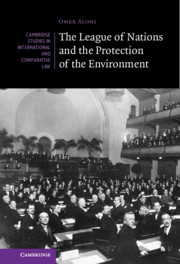Book contents
- The League of Nations and the Protection of the Environment
- Cambridge Studies in International and Comparative Law: 159
- The League of Nations and the Protection of the Environment
- Copyright page
- Contents
- Acknowledgments
- Introduction
- 1 Fighting Pollution Made by Humankind
- 2 The League of Nations and the Whaling Dilemma
- 3 Sanitation, Spreading Diseases, and Environmental Concerns: The League of Nations’ Campaign for Rural Hygiene
- 4 Raw Materials, the Timber Crisis, and Fears of Deforestation during the Interwar Period
- 5 Evaluating the Environmental Regime of the League of Nations: Comparative Discussion
- Conclusion
- Bibliography
- Index
- Cambridge Studies in International and Comparative Law
Introduction
Published online by Cambridge University Press: 30 April 2021
- The League of Nations and the Protection of the Environment
- Cambridge Studies in International and Comparative Law: 159
- The League of Nations and the Protection of the Environment
- Copyright page
- Contents
- Acknowledgments
- Introduction
- 1 Fighting Pollution Made by Humankind
- 2 The League of Nations and the Whaling Dilemma
- 3 Sanitation, Spreading Diseases, and Environmental Concerns: The League of Nations’ Campaign for Rural Hygiene
- 4 Raw Materials, the Timber Crisis, and Fears of Deforestation during the Interwar Period
- 5 Evaluating the Environmental Regime of the League of Nations: Comparative Discussion
- Conclusion
- Bibliography
- Index
- Cambridge Studies in International and Comparative Law
Summary
By telling the story of interwar environmental perspectives, the introduction wishes to navigate and explain different trends in the history of global environmental law and in studies on the League. Using these questions to track possible links between history, law, and environment, the book shall explore those opportunities in environmental law and international relations in which the League was so deeply involved. As the introduction will explain, this reclaiming of the past enables us to deepen the conventional analysis beyond what we would describe as “historiographic amnesia,” which is typically characteristic of research about the League, as exemplified by the paradigm of the Rise and Fall of the League of Nations. As such, the story of the League as a whole, with its different (and sometimes inconsistent) challenges – which up until now have been missing from both the history of international law and environmental history – serves as fresh territory for new, unique exploration. The introduction will show how the two different research fields – that of the interwar period, and that of the evolution of international environmental law – can be bridged together by revealing the exciting plot of the environmental regime of the League
Keywords
- Type
- Chapter
- Information
- Publisher: Cambridge University PressPrint publication year: 2021

